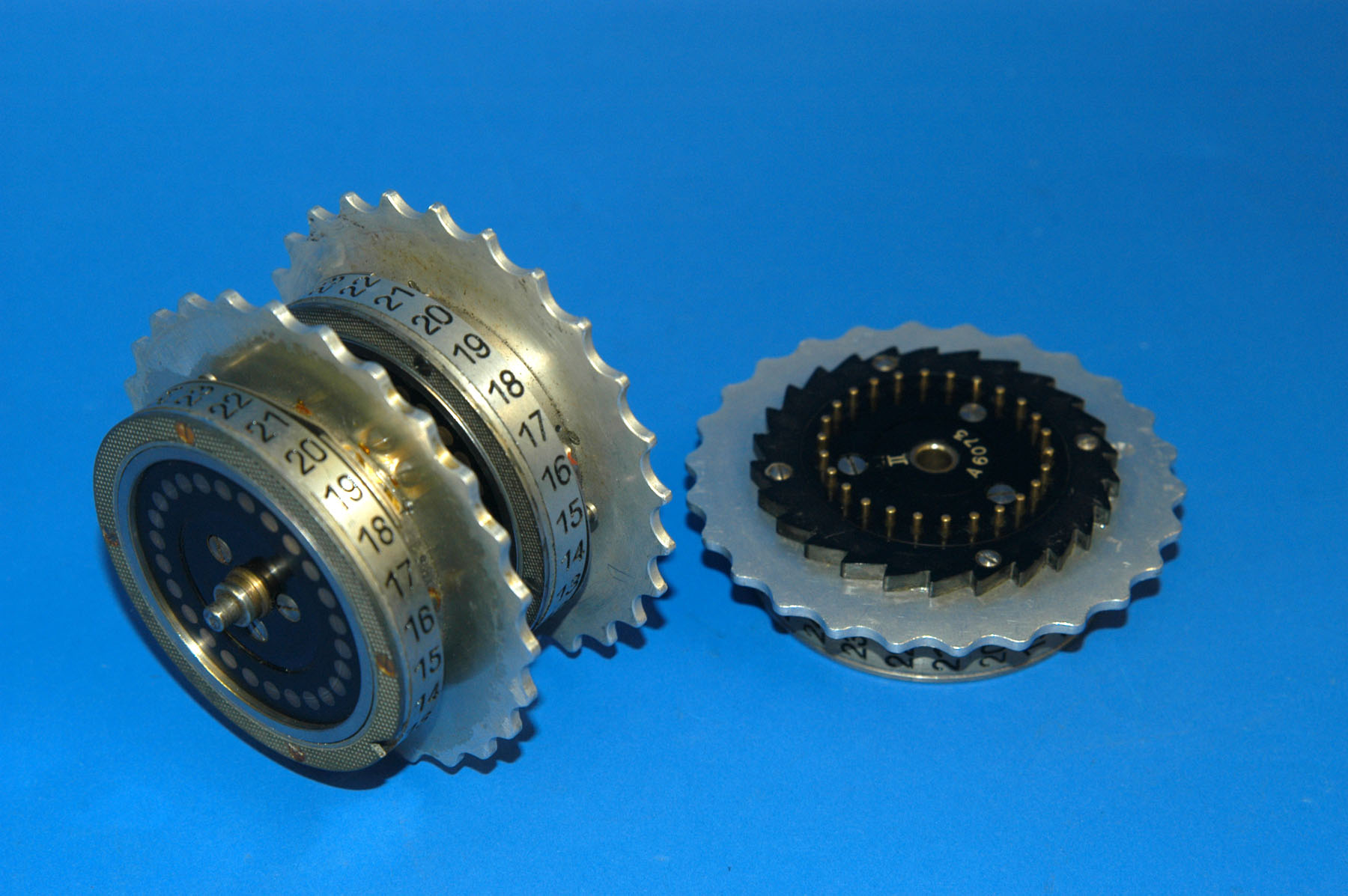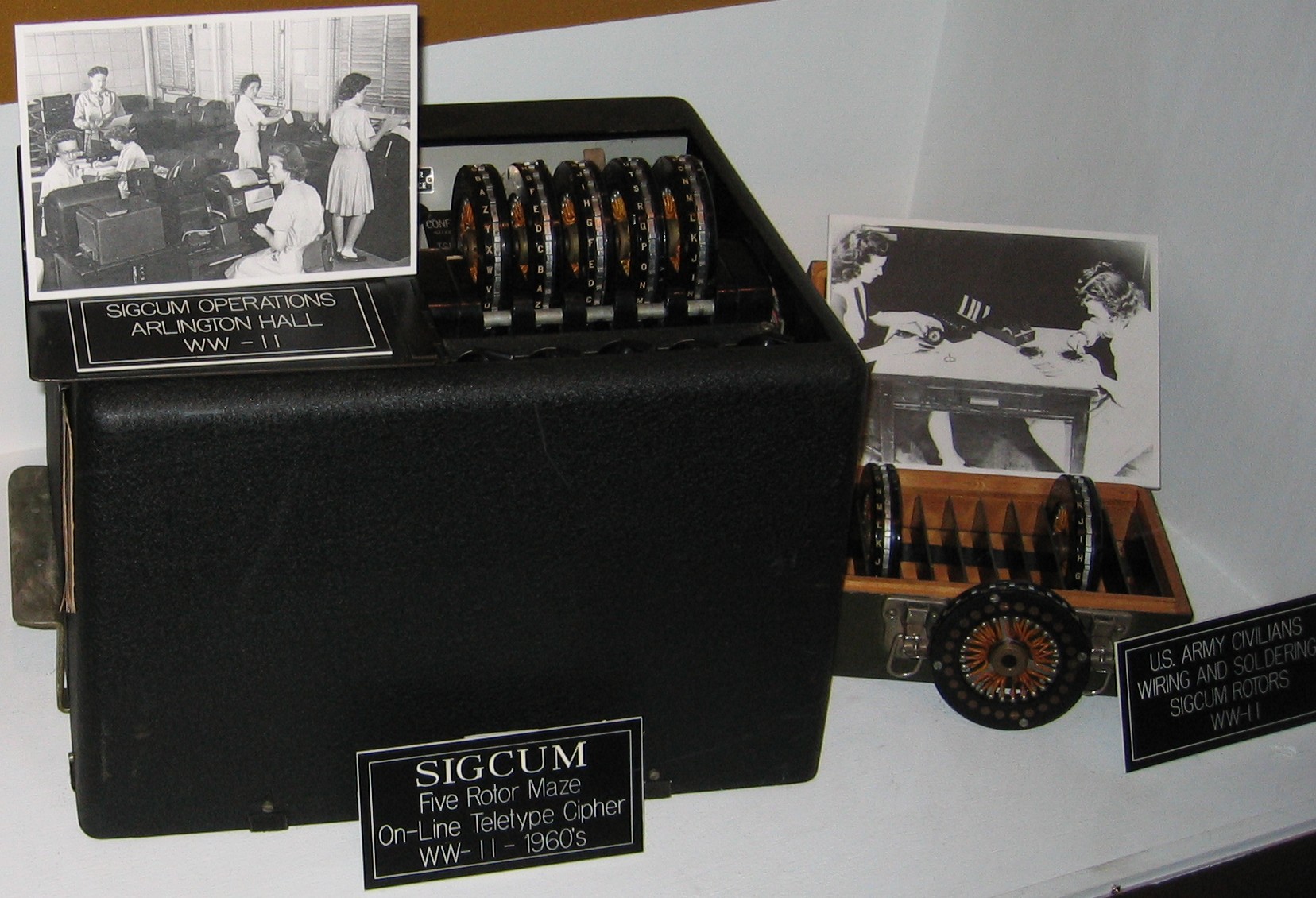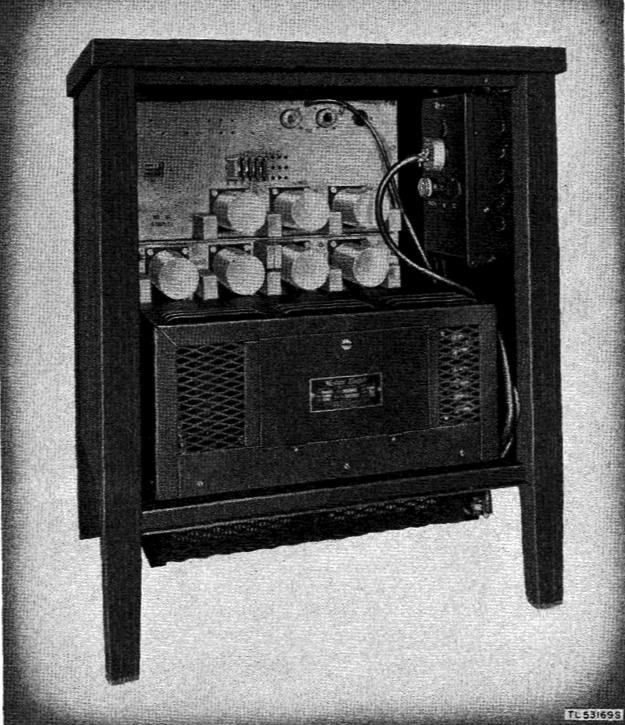|
Fialka
In cryptography, Fialka (M-125) is the name of a Cold War-era Soviet cipher machine. A rotor machine, the device uses 10 rotors, each with 30 contacts along with mechanical pins to control stepping. It also makes use of a punched card mechanism. ''Fialka'' means "violet" in Russian. Information regarding the machine was quite scarce until c. 2005 because the device had been kept secret. Fialka contains a five-level paper tape reader on the right hand side at the front of the machine, and a paper tape punch and tape printing mechanism on top. The punched-card input for keying the machine is located on the left hand side. The Fialka requires 24 volt DC power and comes with a separate power supply that accepts power at 100 to 250 VAC, 50–400 Hz by means of an external selector switch. The machine's rotors are labelled with Cyrillic, requiring 30 points on the rotors; this is in contrast to many comparable Western machines with 26-contact rotors, corresponding to the Lati ... [...More Info...] [...Related Items...] OR: [Wikipedia] [Google] [Baidu] |
Rotor Machine
In cryptography, a rotor machine is an electro-mechanical stream cipher device used for encrypting and decrypting messages. Rotor machines were the cryptographic state-of-the-art for much of the 20th century; they were in widespread use in the 1920s–1970s. The most famous example is the German Enigma machine, the output of which was deciphered by the Allies during World War II, producing intelligence code-named ''Ultra''. Description The primary component of a rotor machine is a set of ''rotors'', also termed ''wheels'' or ''drums'', which are rotating disks with an array of electrical contacts on either side. The wiring between the contacts implements a fixed substitution of letters, replacing them in some complex fashion. On its own, this would offer little security; however, before or after encrypting each letter, the rotors advance positions, changing the substitution. By this means, a rotor machine produces a complex polyalphabetic substitution cipher, which changes ... [...More Info...] [...Related Items...] OR: [Wikipedia] [Google] [Baidu] |
Rotor Machines
In cryptography, a rotor machine is an electro-mechanical stream cipher device used for encrypting and decrypting messages. Rotor machines were the cryptographic state-of-the-art for much of the 20th century; they were in widespread use in the 1920s–1970s. The most famous example is the German Enigma machine, the output of which was deciphered by the Allies during World War II, producing intelligence code-named ''Ultra''. Description The primary component of a rotor machine is a set of ''rotors'', also termed ''wheels'' or ''drums'', which are rotating disks with an array of electrical contacts on either side. The wiring between the contacts implements a fixed substitution of letters, replacing them in some complex fashion. On its own, this would offer little security; however, before or after encrypting each letter, the rotors advance positions, changing the substitution. By this means, a rotor machine produces a complex polyalphabetic substitution cipher, which changes ... [...More Info...] [...Related Items...] OR: [Wikipedia] [Google] [Baidu] |
Rotor Machine
In cryptography, a rotor machine is an electro-mechanical stream cipher device used for encrypting and decrypting messages. Rotor machines were the cryptographic state-of-the-art for much of the 20th century; they were in widespread use in the 1920s–1970s. The most famous example is the German Enigma machine, the output of which was deciphered by the Allies during World War II, producing intelligence code-named ''Ultra''. Description The primary component of a rotor machine is a set of ''rotors'', also termed ''wheels'' or ''drums'', which are rotating disks with an array of electrical contacts on either side. The wiring between the contacts implements a fixed substitution of letters, replacing them in some complex fashion. On its own, this would offer little security; however, before or after encrypting each letter, the rotors advance positions, changing the substitution. By this means, a rotor machine produces a complex polyalphabetic substitution cipher, which changes ... [...More Info...] [...Related Items...] OR: [Wikipedia] [Google] [Baidu] |
NEMA (machine)
In the history of cryptography, the NEMA (NEue MAschine) ("new machine"), also designated the T-D (Tasten-Druecker-Maschine) ("key-stroke machine"), was a 10-wheel rotor machine designed by the Swiss Army during the World War II as a replacement for their Enigma machines. History The Swiss became aware that their current machine, a commercial Enigma (the Swiss K), had been broken by both Allied and German cryptanalysts. A new design was begun between 1941 and 1943 by Captain Arthur Alder, a professor of mathematics at the University of Bern. The team which designed the machine also included Professors Hugo Hadwiger and Heinrich Emil Weber. :de:Heinrich Emil Weber In the spring of 1944, the first prototype had become available. After some modifications, the design was accepted in March 1945, and production of 640 machines began the following month by Zellweger AG. The first machine entered service in 1947. NEMA was declassified on 9 July 1992, and machines were offered for s ... [...More Info...] [...Related Items...] OR: [Wikipedia] [Google] [Baidu] |
Cryptographic Hardware
Cryptography, or cryptology (from grc, , translit=kryptós "hidden, secret"; and ''graphein'', "to write", or ''-logia'', "study", respectively), is the practice and study of techniques for secure communication in the presence of adversarial behavior. More generally, cryptography is about constructing and analyzing protocols that prevent third parties or the public from reading private messages. Modern cryptography exists at the intersection of the disciplines of mathematics, computer science, information security, electrical engineering, digital signal processing, physics, and others. Core concepts related to information security ( data confidentiality, data integrity, authentication, and non-repudiation) are also central to cryptography. Practical applications of cryptography include electronic commerce, chip-based payment cards, digital currencies, computer passwords, and military communications. Cryptography prior to the modern age was effectively synonymous ... [...More Info...] [...Related Items...] OR: [Wikipedia] [Google] [Baidu] |
German Democratic Republic
German(s) may refer to: * Germany (of or related to) ** Germania (historical use) * Germans, citizens of Germany, people of German ancestry, or native speakers of the German language ** For citizens of Germany, see also German nationality law **Germanic peoples (Roman times) * German language **any of the Germanic languages * German cuisine, traditional foods of Germany People * German (given name) * German (surname) * Germán, a Spanish name Places * German (parish), Isle of Man * German, Albania, or Gërmej * German, Bulgaria * German, Iran * German, North Macedonia * German, New York, U.S. * Agios Germanos, Greece Other uses * German (mythology) German (GER-man, ) is a South Slavic mythological being, recorded in the folklore of eastern Serbia and northern Bulgaria. He is a male spirit associated with bringing rain and hail. His influence on these precipitations can be positive, resulting ..., a South Slavic mythological being * Germans (band), a Canadian ro ... [...More Info...] [...Related Items...] OR: [Wikipedia] [Google] [Baidu] |
Foreign Policy (magazine)
''Foreign Policy'' is an American news publication, founded in 1970 and focused on global affairs, current events, and domestic and international policy. It produces content daily on its website and app, and in four print issues annually. ''Foreign Policy'' magazine and ForeignPolicy.com are published by The FP Group, a division of Graham Holdings Company (formerly The Washington Post Company). The FP Group also produces FP Events, ''Foreign Policy''s events division, launched in 2012. History ''Foreign Policy'' was founded in late 1970 by Samuel P. Huntington, professor of Harvard University, and his friend Warren Demian Manshel to give a voice to alternative views about American foreign policy at the time of the Vietnam War. Huntington hoped it would be "serious but not scholarly, lively but not glib". In early 1978, after six years of close partnership, the Carnegie Endowment for International Peace acquired full ownership of ''Foreign Policy''. In 2000, a format change ... [...More Info...] [...Related Items...] OR: [Wikipedia] [Google] [Baidu] |
KL-7
The TSEC/KL-7, also known as Adonis was an off-line non-reciprocal rotor encryption machine.A History of U.S. Communications Security; the David G. Boak Lectures National Security Agency (NSA), Volume I, 1973, partially released 2008, additional portions declassified October 14, 2015 The KL-7 had rotors to encrypt the text, most of which moved in a complex pattern, controlled by notched rings. The non-moving rotor was fourth from the left of the stack. The KL-7 also encrypted the message indicator. History and development In 1952, the machine was introduced by AFSA's successor, the |
Tempest (codename)
TEMPEST is a U.S. National Security Agency specification and a NATO certification referring to spying on information systems through leaking emanations, including unintentional radio or electrical signals, sounds, and vibrations. TEMPEST covers both methods to spy upon others and how to shield equipment against such spying. The protection efforts are also known as emission security (EMSEC), which is a subset of communications security (COMSEC). The NSA methods for spying on computer emissions are classified, but some of the protection standards have been released by either the NSA or the Department of Defense. Protecting equipment from spying is done with distance, shielding, filtering, and masking. The TEMPEST standards mandate elements such as equipment distance from walls, amount of shielding in buildings and equipment, and distance separating wires carrying classified vs. unclassified materials, filters on cables, and even distance and shielding between wires or equipment and b ... [...More Info...] [...Related Items...] OR: [Wikipedia] [Google] [Baidu] |
Cryptoperiod
A cryptoperiod is the time span during which a specific cryptographic key is authorized for use. Common government guidelines range from 1 to 3 years for asymmetric cryptography, and 1 day to 7 days for symmetric cipher traffic keys. Factors to consider include the strength of the underlying encryption algorithm, key length, the likelihood of compromise through a security breach and the availability of mechanisms of revoking keys. In traditional cryptographic practice, keys were changed at regular intervals, typically at the same time each day. The code word for a key change, in NSA parlance, is HJ or Hotel Juliet in the NATO phonetic alphabet. When cryptographic devices began to be used in large scale, those who had to update the key had to set a specific time to synchronize the re-key. This was accomplished at the hour (H) the Julian (J) Date changed, among crypto-accountants, managers and users the jargon "HJ" became the accepted term meaning it was time to change the crypto- ... [...More Info...] [...Related Items...] OR: [Wikipedia] [Google] [Baidu] |





